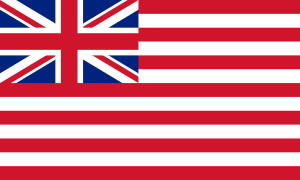ผลต่างระหว่างรุ่นของ "บริษัทอินเดียตะวันออก"
ล โรบอต แก้ไข: ta:பிரித்தானிய கிழக்கிந்திய நிறுவனம் |
ล r2.7.1) (โรบอต แก้ไข: it:Compagnia britannica delle Indie orientali |
||
| บรรทัด 36: | บรรทัด 36: | ||
[[hu:Brit Kelet-indiai Társaság]] |
[[hu:Brit Kelet-indiai Társaság]] |
||
[[id:Perusahaan Hindia Timur Britania]] |
[[id:Perusahaan Hindia Timur Britania]] |
||
[[it:Compagnia |
[[it:Compagnia britannica delle Indie orientali]] |
||
[[ja:イギリス東インド会社]] |
[[ja:イギリス東インド会社]] |
||
[[kn:ಬ್ರಿಟಿಷ್ ಈಸ್ಟ್ ಇಂಡಿಯ ಕಂಪನಿ]] |
[[kn:ಬ್ರಿಟಿಷ್ ಈಸ್ಟ್ ಇಂಡಿಯ ಕಂಪನಿ]] |
||
รุ่นแก้ไขเมื่อ 01:42, 28 มีนาคม 2554

บริษัทอินเดียตะวันออก (หรือเรียกว่า บริษัทการค้าอินเดียตะวันออก, บริษัทอินเดียตะวันออกของอังกฤษ[1] และในเวลาต่อมา บริษัทอินเดียตะวันออกของบริเตน[2]) เป็นบริษัทร่วมทุนสัญชาติอังกฤษในช่วงแรก ซึ่งเดิมถูกก่อตั้งขึ้นเพื่อแสวงหาการค้ากับอินเดียตะวันออก แต่ในภายหลังได้ดำเนินการค้าส่วนใหญ่กับอนุทวีปอินเดียและจีน บริษัทอินเดียตะวันออกถือได้ว่ามีความเก่าแก่ที่สุดเมื่อเทียบกับบริษัทอินเดียตะวันออกของชาติทวีปยุโรปอื่น ๆ ซึ่งก่อตั้งขึ้น บริษัทได้รับพระราชทานอนุญาตจากพระมหากษัตริย์อังกฤษ ภายใต้ชื่อ ผู้ว่าการและบริษัทพ่อค้าแห่งการค้าจากลอนดอนไปยังอินเดียตะวันออก โดย สมเด็จพระราชินีนาถเอลิซาเบธที่ 1 แห่งอังกฤษ เมื่อวันที่ 31 ธันวาคม ค.ศ. 1600[3] หลังจากการแข่งขันกับบริษัทอังกฤษที่เป็นซึ่งท้าทายการผูกขาดในช่วงปลายคริสต์ศตวรรษที่ 17 ทั้งสองบริษัทได้รวมเข้าด้วยกันในปี ค.ศ. 1708 เพื่อจัดตั้ง สหบริษัทพ่อค้าแห่งการค้าระหว่างอังกฤษกับอินเดียตะวันออก หรือที่เรียกกันในภาษาปากว่า บริษัทจอห์น[4]
อ้างอิง
- ↑ Encyclopaedia Britannica 2008, "East India Company"
- ↑ 1. Columbia Encyclopedia 2007, "East India Company, British". 2. Marx, Karl (June 25, 1853), "The British rule in India", New York Daily Tribune republished in Carter, Mia; Harlow (editors), Barbara (2003), Archives of Empire, Raleigh: Duke University Press. Pp. 802, ISBN 0822331640
{{citation}}:|last2=มีชื่อเรียกทั่วไป (help). Quote (p. 118): "I do not allude to European despotism, planted upon Asiatic despotism, by the British East India Company, forming a more monstrous combination than any of the divine monsters startling us in the temple of Salsette." - ↑ The Register of Letters &c. of the Governor and Company of Merchants of London trading into the East Indies, 1600–1619. On page 3, a letter written by Elizabeth I on January 23, 1601 ("Witnes or selfe at Westminster the xxiiijth of Ianuarie in the xliijth yeare of or Reigne.") states, "Haue been pleased to giue lysence vnto or said Subjects to proceed in the said voiadgs, & for the better inabling them to establish a trade into & from the said East Indies Haue by or tres Pattents vnder or great seale of England beareing date at Westminster the last daie of december last past incorporated or said Subjecte by the name of the Gournor & Companie of the merchaunts of London trading into the East Indies, & in the same tres Pattents haue geven them the sole trade of theast Indies for the terme of XVteen yeares ..."
- ↑ Ride, Lindsay; Ride, May; Mellor, Bernard (1995), An East India Company Cemetery: Protestant Burials in Macao, Hong Kong: Hong Kong University Press. Pp. 304, ISBN 9622093841 Quote (p. 7): "In 1709, the Company amalgamated with a rival group, which had been chartered in 1698 by William III. This union took the title 'The Honourable East India Company,' which was shortened for general use to 'the Honourable Company' and more often still to John Company, until it ceased operations in 1834, after its monopoly of British trade with China was discontinued."
